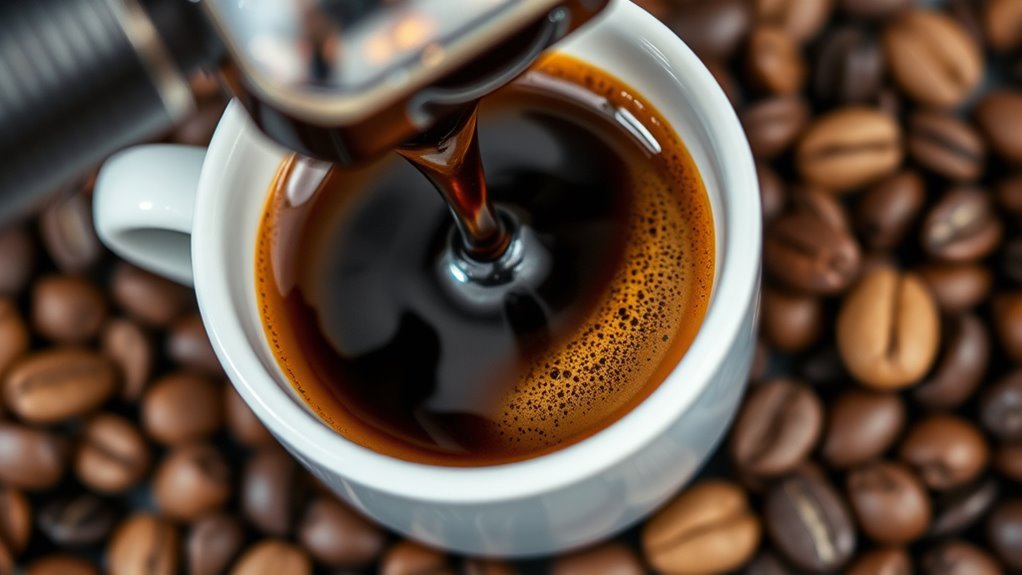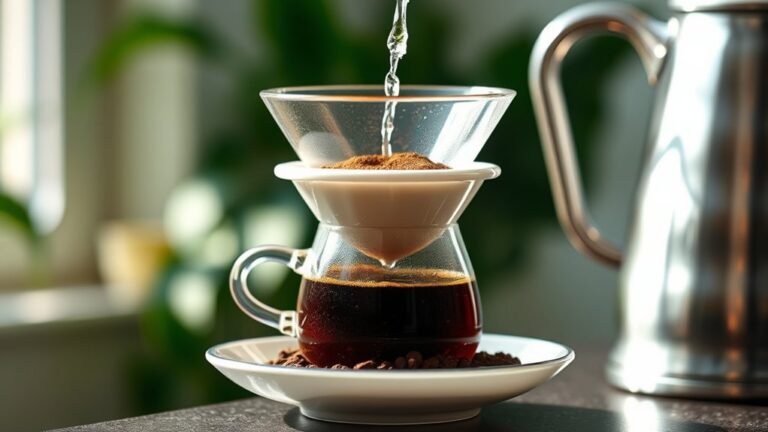Can I Use Any Coffee for Espresso
You can’t use just any coffee for espresso. The choice of coffee beans greatly affects flavor and quality. Espresso typically benefits from dark roasts, which provide rich, chocolatey notes. Beans should also be fresh and ideally ground to a medium consistency for best extraction. Experimenting with different origins can also enhance your espresso experience. If you’re curious about how grind size and brewing methods influence your coffee, there’s more to discover on perfecting your espresso technique.
Understanding Espresso and Its Characteristics
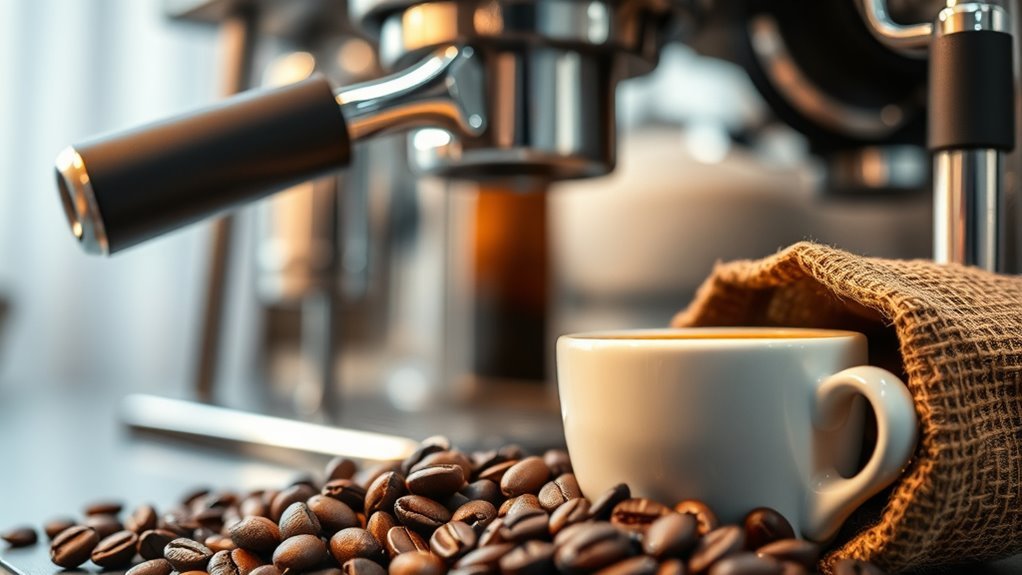
While many people associate espresso with specific coffee beans and blends, understanding its true characteristics reveals that you can use a variety of coffee types to create this concentrated beverage. Espresso is defined by its high pressure brewing method, which extracts intense flavors and oils, resulting in a rich, thick crema. The key espresso characteristics include a robust body, concentrated flavor, and a harmonious balance of acidity and sweetness. Your choice of coffee affects the flavor profile; for instance, a dark roast may lend a chocolatey essence, while a lighter roast could introduce fruity notes. By experimenting with different beans, you can discover unique flavor profiles that suit your palate, embracing the freedom to craft your ideal espresso experience.
The Importance of Coffee Bean Selection
Selecting the right coffee beans plays a significant role in crafting the perfect espresso. The bean origin greatly influences the flavor profile, impacting everything from acidity to sweetness. For instance, beans from Brazil often deliver a nutty, chocolatey taste, while Ethiopian beans can introduce vibrant fruity notes. Knowing where your beans come from allows you to tailor your espresso experience to your preferences. Look for blends or single-origin beans that align with your desired flavor characteristics. Furthermore, freshness is key; older beans can lead to a lackluster extraction. By carefully choosing your coffee beans based on origin and flavor profile, you empower yourself to create a truly exceptional espresso that reflects your unique taste and style.
Grind Size and Its Impact on Extraction
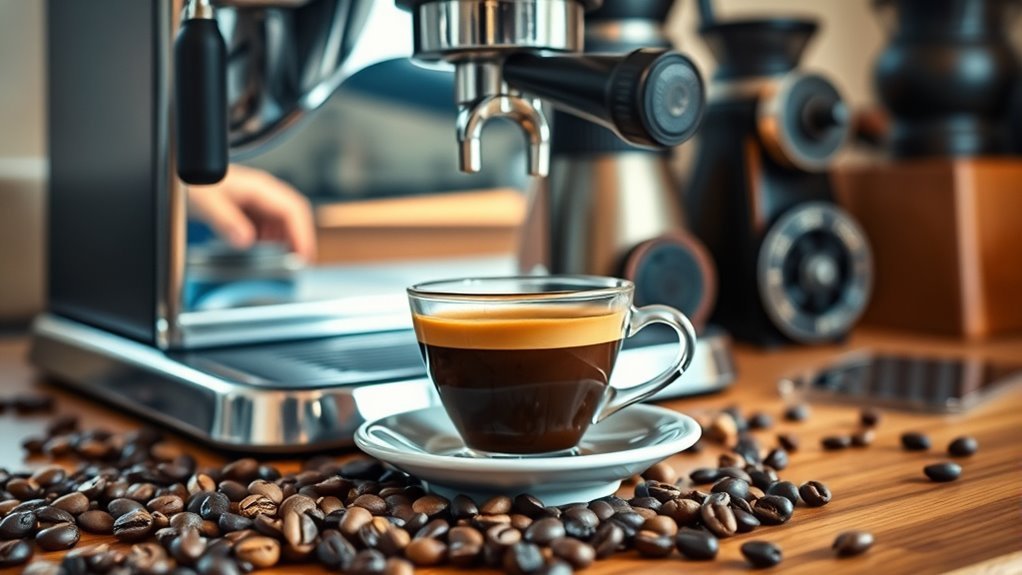
Grind size plays a crucial role in espresso extraction, as it directly affects the surface area of the coffee that comes into contact with water. Achieving the right grind consistency is essential for optimizing extraction time. If the grind is too fine, you might over-extract, leading to bitterness; if it’s too coarse, under-extraction can occur, resulting in a sour taste.
Here’s a concise table outlining the impact of grind size on extraction:
| Grind Size | Extraction Time | Flavor Profile |
|---|---|---|
| Coarse | Shorter | Sour, under-extracted |
| Medium | Ideal | Balanced, nuanced |
| Fine | Longer | Bitter, over-extracted |
Experimenting With Different Coffee Roasts
When you experiment with different coffee roasts for espresso, you’ll discover that each roast brings unique flavor profiles and extraction characteristics. Light roasts typically yield brighter acidity and floral notes, while dark roasts offer deeper, bolder flavors with chocolate and caramel undertones. The roast level affects the solubility of the coffee compounds, influencing how quickly flavors extract during brewing. You’ll notice that lighter roasts may require finer grind sizes to enhance extraction, while darker roasts can handle coarser grinds without losing their intensity. By adjusting variables like brew time and water temperature, you can reveal a spectrum of flavors. Don’t hesitate to explore various combinations, as each roast can lead to a unique espresso experience that suits your personal palate.
Brewing Methods: Beyond the Espresso Machine
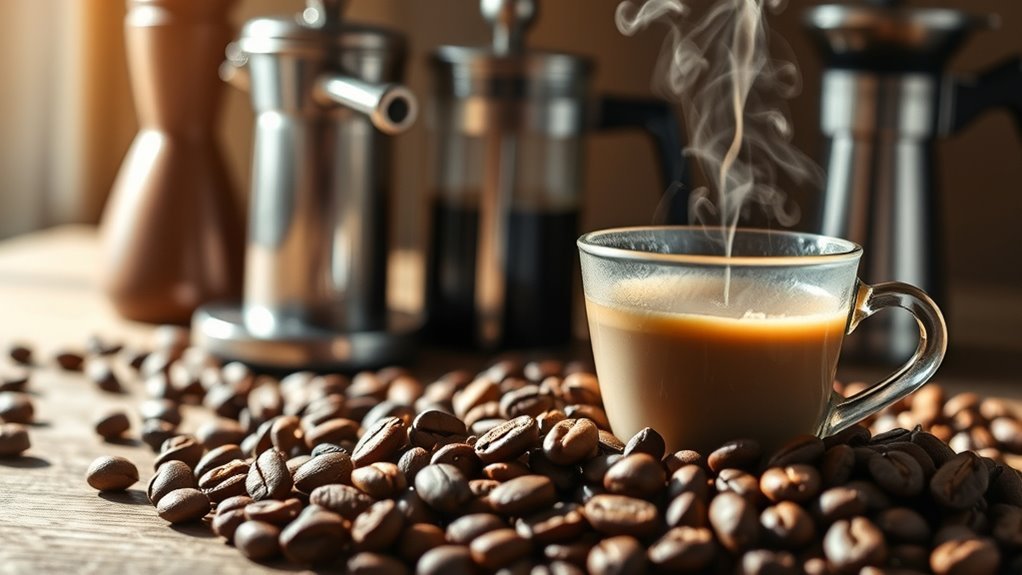
When you consider brewing espresso, it’s essential to explore methods beyond the traditional espresso machine. Techniques like AeroPress and Moka pots can yield rich flavors, but the grind size plays a significant role in extraction efficiency. Adjusting your grind for these alternative methods can help you achieve a satisfying espresso-like experience, regardless of the equipment you use.
Alternative Brewing Techniques
Although espresso is often associated with specialized machines, there are various alternative brewing techniques that can produce rich, concentrated coffee flavors without the need for traditional equipment. These methods offer you the freedom to explore espresso variations using different tools and techniques.
| Brewing Method | Description | Strength Level |
|---|---|---|
| Aeropress | Uses air pressure for extraction | Medium to Strong |
| Moka Pot | Stovetop method creating steam | Strong |
| French Press | Immersion brewing with coarse grind | Medium |
Grind Size Importance
The grind size of your coffee beans plays an essential role in the extraction process, greatly impacting the flavor and strength of your brew. For espresso, achieving the right grind consistency is critical; too fine and you risk over-extraction, too coarse and it leads to under-extraction. This balance is important for creating that rich, full-bodied shot you desire. Making grind adjustments allows you to fine-tune your extraction based on bean type, freshness, and brewing method. If you’re experimenting with alternative brewing techniques, remember that each method may require different grind sizes. Keeping these variables in mind empowers you to customize your coffee experience, ensuring you harness the full potential of your chosen beans. Enjoy the freedom to explore!
Tips for Perfecting Your Homemade Espresso
To achieve a consistently delicious homemade espresso, it’s essential to pay close attention to several key factors. First, always use freshly roasted, high-quality coffee beans to avoid common espresso myths that suggest any coffee will suffice. Next, focus on the grind size; a fine grind is critical for ideal extraction. Monitor your brewing temperature—ideally between 195°F and 205°F—to guarantee you’re hitting the brewing essentials. Pressure is fundamental; aim for 9 bars during extraction for a rich, flavorful shot. Finally, don’t overlook the importance of your equipment; a reliable espresso machine and a good tamper can elevate your brewing experience. By mastering these elements, you’ll gain the freedom to create espresso that rivals your favorite café.
Frequently Asked Questions
Can I Use Flavored Coffee for Espresso?
You can use flavored coffee for espresso, but it’s essential to contemplate the flavored coffee characteristics. These coffees often have added oils or syrups that can alter the espresso taste profile, potentially affecting extraction and crema. If you enjoy unique flavors, go ahead, but be aware that the intensity of the added flavors might overwhelm the traditional espresso notes. Experimenting can lead to enjoyable results, so don’t hesitate to explore different options!
Does Espresso Require a Specific Coffee Origin?
Espresso doesn’t require a specific coffee origin, but the choice can influence its characteristics. You’ll find that beans from different regions offer unique flavors and aromas. For instance, South American coffees are often bright and fruity, while African beans might bring floral notes. The key is to select high-quality, freshly roasted coffee. Ultimately, it’s about personal preference and experimenting with various origins to achieve the espresso profile you enjoy most.
How Long Should Coffee Beans Be Stored Before Use?
When it comes to coffee storage, the freshness impact is essential. Ideally, you should use your beans within two to four weeks after roasting for best flavor. Storing them in an airtight container, away from light, heat, and moisture, helps maintain their quality. If you wait too long, the beans lose their vibrant flavors, making your brew less enjoyable. So, aim to enjoy that fresh cup sooner rather than later!
Can I Mix Different Coffee Types for Espresso?
Yes, you can mix different coffee types for espresso. Combining various bean blends allows you to create unique flavor profiles that enhance your espresso experience. Experimenting with different origins and roast levels can yield a balanced cup, highlighting both brightness and depth. Just remember to maintain a consistent grind size to guarantee even extraction. So, don’t hesitate to explore; the freedom to customize your espresso can lead to delightful discoveries.
Is Decaf Coffee Suitable for Espresso Brewing?
Decaf coffee can definitely be suitable for espresso brewing, but the espresso taste may differ from regular coffee. When you use decaf, you’re sacrificing some of the vibrant flavors and acidity that come from fully caffeinated beans. However, if you prefer decaf, choose a high-quality blend specifically designed for espresso. This way, you’ll still enjoy a rich, full-bodied shot without the caffeine kick, allowing for a more relaxed coffee experience.
